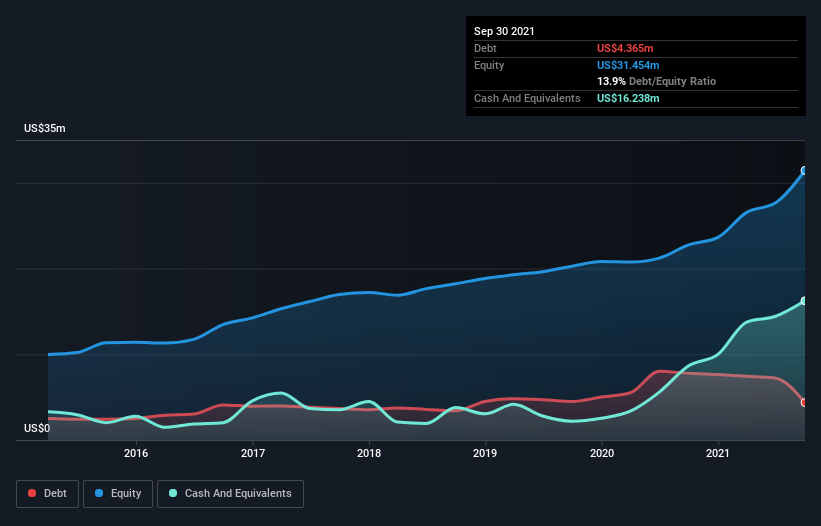Is Smith-Midland (NASDAQ:SMID) A Risky Investment?
Warren Buffett famously said, 'Volatility is far from synonymous with risk.' When we think about how risky a company is, we always like to look at its use of debt, since debt overload can lead to ruin. We note that Smith-Midland Corporation (NASDAQ:SMID) does have debt on its balance sheet. But the real question is whether this debt is making the company risky.
Why Does Debt Bring Risk?
Debt and other liabilities become risky for a business when it cannot easily fulfill those obligations, either with free cash flow or by raising capital at an attractive price. If things get really bad, the lenders can take control of the business. However, a more usual (but still expensive) situation is where a company must dilute shareholders at a cheap share price simply to get debt under control. Of course, the upside of debt is that it often represents cheap capital, especially when it replaces dilution in a company with the ability to reinvest at high rates of return. The first thing to do when considering how much debt a business uses is to look at its cash and debt together.
View our latest analysis for Smith-Midland
How Much Debt Does Smith-Midland Carry?
You can click the graphic below for the historical numbers, but it shows that Smith-Midland had US$4.37m of debt in September 2021, down from US$7.78m, one year before. However, it does have US$16.2m in cash offsetting this, leading to net cash of US$11.9m.
How Healthy Is Smith-Midland's Balance Sheet?
Zooming in on the latest balance sheet data, we can see that Smith-Midland had liabilities of US$13.0m due within 12 months and liabilities of US$10.8m due beyond that. Offsetting these obligations, it had cash of US$16.2m as well as receivables valued at US$13.1m due within 12 months. So it can boast US$5.50m more liquid assets than total liabilities.
This short term liquidity is a sign that Smith-Midland could probably pay off its debt with ease, as its balance sheet is far from stretched. Succinctly put, Smith-Midland boasts net cash, so it's fair to say it does not have a heavy debt load!
Better yet, Smith-Midland grew its EBIT by 112% last year, which is an impressive improvement. That boost will make it even easier to pay down debt going forward. The balance sheet is clearly the area to focus on when you are analysing debt. But it is Smith-Midland's earnings that will influence how the balance sheet holds up in the future. So when considering debt, it's definitely worth looking at the earnings trend. Click here for an interactive snapshot.
Finally, a business needs free cash flow to pay off debt; accounting profits just don't cut it. Smith-Midland may have net cash on the balance sheet, but it is still interesting to look at how well the business converts its earnings before interest and tax (EBIT) to free cash flow, because that will influence both its need for, and its capacity to manage debt. During the last three years, Smith-Midland produced sturdy free cash flow equating to 71% of its EBIT, about what we'd expect. This cold hard cash means it can reduce its debt when it wants to.
Summing up
While it is always sensible to investigate a company's debt, in this case Smith-Midland has US$11.9m in net cash and a decent-looking balance sheet. And it impressed us with its EBIT growth of 112% over the last year. So is Smith-Midland's debt a risk? It doesn't seem so to us. The balance sheet is clearly the area to focus on when you are analysing debt. However, not all investment risk resides within the balance sheet - far from it. To that end, you should be aware of the 2 warning signs we've spotted with Smith-Midland .
When all is said and done, sometimes its easier to focus on companies that don't even need debt. Readers can access a list of growth stocks with zero net debt 100% free, right now.
Have feedback on this article? Concerned about the content? Get in touch with us directly. Alternatively, email editorial-team (at) simplywallst.com.
This article by Simply Wall St is general in nature. We provide commentary based on historical data and analyst forecasts only using an unbiased methodology and our articles are not intended to be financial advice. It does not constitute a recommendation to buy or sell any stock, and does not take account of your objectives, or your financial situation. We aim to bring you long-term focused analysis driven by fundamental data. Note that our analysis may not factor in the latest price-sensitive company announcements or qualitative material. Simply Wall St has no position in any stocks mentioned.

